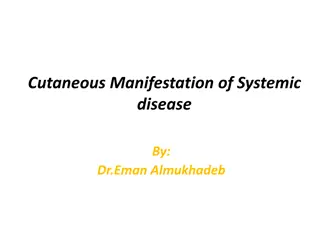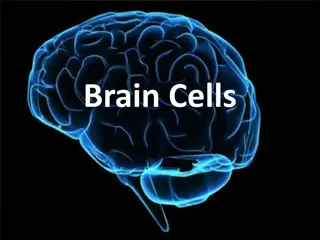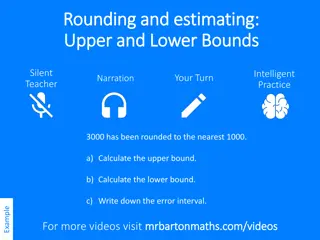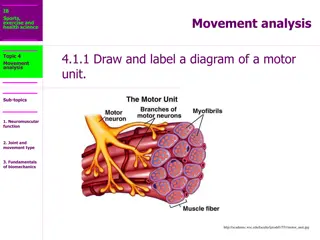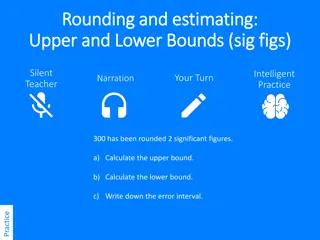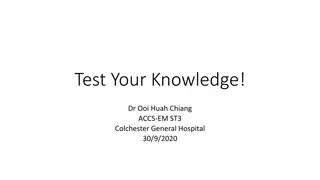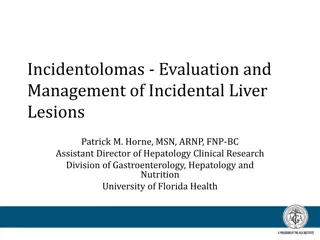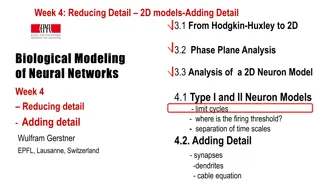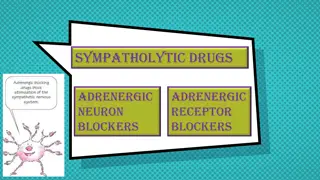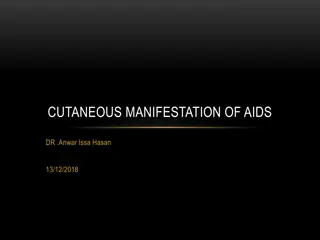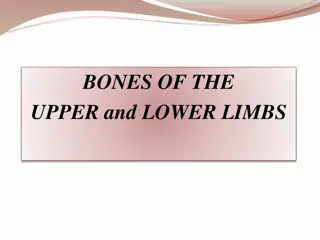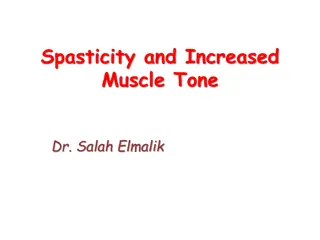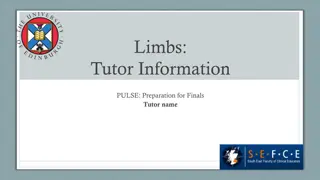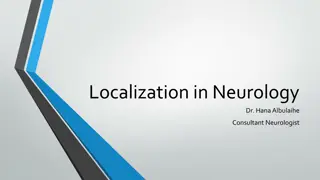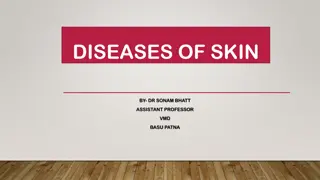Understanding Upper and Lower Motor Neuron Lesions: Effects and Manifestations
This content delves into the intricacies of upper and lower motor neuron lesions, detailing their effects and manifestations in the human body. It explores the causes, types of paralysis, reflexes, muscle tone changes, and the impact of lesions at various levels of the motor system. The insights provided offer a comprehensive understanding of the complexities associated with these neurological conditions.
Download Presentation

Please find below an Image/Link to download the presentation.
The content on the website is provided AS IS for your information and personal use only. It may not be sold, licensed, or shared on other websites without obtaining consent from the author. Download presentation by click this link. If you encounter any issues during the download, it is possible that the publisher has removed the file from their server.
E N D
Presentation Transcript
UPPER & LOWER MOTOR NEURON lesion By Dr FawziaALROuq Ph.D Assistant Professor of physiology Consultant of neurophysiology Department of Physiology College of Medicine, King Saud UniversityUniversity
Objectives Appreciate what is meant by upper and lower motor neurons Explain manifestations of upper and lower motor neurons lesions Know effects of lesion in pyramidal tracts at various levels Know effects of lesion in the internal capsule Explain the manifestations of complete spinal cord transection and hemisection.
Upper and Lower motor neurones
Causes of UMNL &LMNL Upper Motor Neuron Lesion,UMNL 5 Can be due to Lower Motor Neuron Lesion,LMNL Can result from (1)Cerebral stroke by haemorrhage , thrombosis or embolism (2)Spinal cord transection or hemisection (Brown- Sequard syndrome ) (1)Anterior horn cell lesions ( e.g. , poliomyelitis, motor neuron disease ) (2) Spinal root lesions or peripheral nerve lesion ( e.g. nerve injury by trauma or compressive lesion) 17 October 2017
UMNL LMNL 1-extent ofparalysis widwspread localized 2-site ofparalysis Opposite side tolesion Same side oflesion Spasticity ( hypertonia) clasp-knifespasticity 3-Tone ofmuscles Hypotonia flaccid paralysis 4- Deepreflexes Brisk ( exaggerated) tendonjerks Diminished orabsent 5- Superficial reflexes absent absent Extensor plantar reflex , Babinskisign ( dorsiflexion of the big toe and fanningout of the other toes ) , or just an upgoing toe. 6-Planter reflex Absent . Marked muscle wasting (atrophy) 7-musclewaisting No marked muscle wasting , but minor wasting may occur due to( disuseatrophy) 8-Clonus No clonus Clonus present ( rhythmic oscillation on tendon stretch) 9-Fasciculations (seen ). - Fibrillation potentials byEMG . No fasciculations No fibrillation potential Fasciculations may be seen . & Fibrillation byEMG
The effect of a lesion in different parts of the motor system Lesions of pyramidal tract cause paralysis of the UMNL type below the levelof the lesion. However, the side affected and the extent of paralysis vary according to the site of thelesion: 1- In area 4: This leads to restricted paralysis e.g. contralateral monoplegia (paralysis of one limb because area 4 is widespread so it is rarely damaged completely. 2- In the corona radiata: This leads to contralateral monoplegia or hemiplegia, depending on the extent of thelesion. 3- In the internal capsule: This often leads to contralateral hemiplegia because almost all fibers are injured
The effect of a lesion in different parts of themotor system
Origin: From area (6) and area (4) descends to corpus striatum Globus pallidus from the globus pallidus fibers pass to; Reticular formation . Vestibular nuclei . Red nucleus Tectum of midbrain. . . From these nuclei the extrapyramidal tracts arise
Motor areas 4 and 6 Corpus striatum Basal Ganglia Globus pallidus Vest. Nuclei RF Red Nucl. Tectum Vest.Spin.T. Rubrospin. T. Tectospin.T. Ret.Spin T.
MOTOR CORTEX INTERNAL CAPSULE BRAIN STEM SPINAL CORD
Def., It is the damage of upper motor neuron in the higher center or the descending motor tract. Causes Trauma .1 Tumour . 2 Vascular disorders as thrombosis or hemorrhage. .3 Sites: Most common site of UMNL is the internal capsule.
Internal capsule Motor loss Sensoryloss Loss of somatic sensations, vision and hearing Hemiplegia
Contralateralparalysis (loss of only voluntary . 1 1 movements) of the distal ms of the limbs, lower facial ms and ms of the tongue. Contralateralparesis(weakness i.e., the ms . 2 2 retains some movements) of the axial ms and upper facial ms. Axialms are supplied by descending motortracts other than CBS whereas ms of the upper face are ipsilaterally innervated by CBS tract.
3) Spasticity (increased ms tone) of the skeletal ms due to increased supraspinal facilitation to -motor neurons. A lesion at the level of internal capsule interrupts the descending inhibitory cortical fibers which feeds the inhibitory reticulospinal tract leaving the facilitatory vestibulospinal and reticulospinal to act. This spasticity is of the clasp-knife type
Facilitatory RF and VST InhibitoryRF
4) Exaggerated tendon jerk & clonus: due to increased supraspinal facilitation. 5) Positive Babinski's sign
The paralyzed ms show no or minimal atrophy as the lower motor neuron is intact and the ms contracts 6) reflexly. 7) Normal response of the paralyzed ms to electric stimulation a)Faradic currentproduces clonic or tetanic contractions b)Galvanic current produces contractions that occur only at closing (make) and opening (break) of the circuits. CCC > ACC > AOC > COC
1) Contralateral hemianaesthesia i.e. loss of all sensations on the opposite side of the body
2) Contralateral homonymous hemianopia i.e., loss of vision in the two opposite halves of the field of vision
3) Bilateral diminution of hearing acuity. No complete loss of hearing as both ears are bilaterally represented in both cortices.
Def., It is damage of the lower motor neurons (the spinal AHCS and the cranial motor nuclei or their axons) resulting in skeletal ms paralysis Causes Trauma Neuropathy
I) Structural changes In Nerve (degeneration and regeneration In muscle (atrophy and increase Ach receptors II) Functional changes 1. Flaccid paralysis 2. Fasciculation and fibrillation 3. Dennervation supersensitivity 4. Reaction of degeneration
A) Flaccidparalysis: Paralysis of denervated ms with loss of all types of movements; "voluntary, postural and reflex". All reflexes are lost including stretch reflex resulting in loss of ms tone and tendon jerk (flaccidity). The extent of paralysis is usually limited to a small group of ms
B) Fasiculations and fibrillations: Appears few days or weeks after denervation Disappear when the motor nerve completely degenerates or successful re-innervation of the ms occurs.
B) Fasiculations : Synchronous visible contraction of the motor unit (all ms fibers) supplied by the injured axon. Result from spontaneous generation of action potential (injury potentials) in distal segment of the injured axon
B) Fibrillations: As degeneration of the injured axon continues, the axon terminals are now separate from the main axon and hence, from each other. Injury potentials are still generated along the terminals leading to asynchronous contraction of the individual ms fibers attached to terminals. Invisible to the observer and detected only by electromyogram (EMG).
C) Denervation supersensitivity: Denervated ms becomes supersensitive to acetylcholine. This is due to increase in the number of A.Ch. receptors which cover the entire surface of ms cell membrane.




